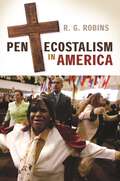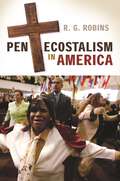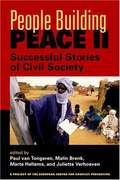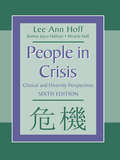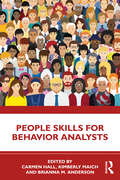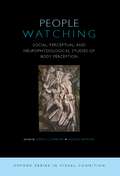- Table View
- List View
Pentecostalism in America
by R.G. RobinsThis book offers a chronological and historical overview the many forms of Pentecostalism within the United States.Pentecostalism is a poorly understood theological movement, despite its recent growth in popularity as well as social and political importance. More and more Americans are encountering neighbors, friends, coworkers, and even political leaders who are aligned with one of the many varieties of American Pentecostalism. In spite of this proliferation, no complete survey of 2lst-century American Pentecostalism exists.In Pentecostalism in America, author R. G. Robins offers an accessible survey of Pentecostalism in the United States, providing a clear, nontechnical introduction and making this complex and rapidly changing movement comprehensible to the general reader. A historical approach to the topic is presented, guiding the reader through the theological, social, and liturgical variants within American Pentecostalism and its major branches, organizations, and institutions; the movement's relation to its offspring; as well as how Pentecostal groups compare to parallel movements in contemporary American Christianity.
Pentecostalism in America
by R.G. RobinsThis book offers a chronological and historical overview the many forms of Pentecostalism within the United States.Pentecostalism is a poorly understood theological movement, despite its recent growth in popularity as well as social and political importance. More and more Americans are encountering neighbors, friends, coworkers, and even political leaders who are aligned with one of the many varieties of American Pentecostalism. In spite of this proliferation, no complete survey of 2lst-century American Pentecostalism exists.In Pentecostalism in America, author R. G. Robins offers an accessible survey of Pentecostalism in the United States, providing a clear, nontechnical introduction and making this complex and rapidly changing movement comprehensible to the general reader. A historical approach to the topic is presented, guiding the reader through the theological, social, and liturgical variants within American Pentecostalism and its major branches, organizations, and institutions; the movement's relation to its offspring; as well as how Pentecostal groups compare to parallel movements in contemporary American Christianity.
People and Change: An Introduction To Counseling and Stress Management
by Catherine M. FlanaganHow to capitalize on change -- as a key feature of modern living - - is the central theme of this work. Incorporating the major theoretical advances psychology has made during the last thirty years, People and Change describes how clinical levels of psychological difficulty can develop and how problems such as phobias, depression, shyness, marital and sexual disharmony, obsessions, and over-indulgence are treated. Although a psychology text, People and Change offers an unusually broad scope. The text acknowledges the interplay of somatic vulnerabilities, environmental influences, large individual differences, and various other factors that can be involved in the complex stress process that leads to bad habits. The ability of the individual to adapt to change through self-knowledge is stressed throughout this important book.
People and Change: An Introduction To Counseling and Stress Management
by Catherine M. FlanaganHow to capitalize on change -- as a key feature of modern living - - is the central theme of this work. Incorporating the major theoretical advances psychology has made during the last thirty years, People and Change describes how clinical levels of psychological difficulty can develop and how problems such as phobias, depression, shyness, marital and sexual disharmony, obsessions, and over-indulgence are treated. Although a psychology text, People and Change offers an unusually broad scope. The text acknowledges the interplay of somatic vulnerabilities, environmental influences, large individual differences, and various other factors that can be involved in the complex stress process that leads to bad habits. The ability of the individual to adapt to change through self-knowledge is stressed throughout this important book.
People and Information: Pergamon General Psychology Series
by Harold B. PepinskyPeople and Information focuses on the problems in information-processing. The selection first takes a look at generalized information systems, including the composition of generalized information systems; initial quantification of information transfer; quantitative consideration of information transfer; and decision making. The text surveys the problems in management development training programs. Concerns include managerial role competence; rationales of management training programs; and role competence in a foreign environment. The book describes the relationship of sociology and attitude of everyday life, including research conducted on this concern. The text also focuses on the factors that affect data-processing system development. Applications of data-processing in the courts, restricted access, delay, and methodology are explained. The book also evaluates the relationship between information-processing and political thoughts and actions. The selection is a vital reference for readers interested in information-processing.
People and Profits?: The Search for A Link Between A Company's Social and Financial Performance (Organization and Management Series)
by Joshua Daniel Margolis James P. WalshWhat is the relationship between the social performance of companies and their financial performance? More colloquially, can a firm effectively attend to both people and profits as it conducts its business? This question has been investigated in no fewer than 95 empirical studies published since 1972. The authors have assembled a compendium of this research to give researchers and practitioners alike a broad overview of these 95 studies and a systematic database detailing the content of each one. This book provides a comprehensive portrait of this research literature. It begins with a broad orientation to the literature, exploring why the link between social and financial performance has been subject to continual inquiry and often heated debate. The authors then present an integrated overview of the 95 studies. Through the charts and tables, the authors illuminate the nature of the studies conducted; the data samples selected for investigation; the ways in which financial and social performance have been measured; and the overall tally of results.
People and Profits?: The Search for A Link Between A Company's Social and Financial Performance (Organization and Management Series)
by Joshua Daniel Margolis James P. WalshWhat is the relationship between the social performance of companies and their financial performance? More colloquially, can a firm effectively attend to both people and profits as it conducts its business? This question has been investigated in no fewer than 95 empirical studies published since 1972. The authors have assembled a compendium of this research to give researchers and practitioners alike a broad overview of these 95 studies and a systematic database detailing the content of each one. This book provides a comprehensive portrait of this research literature. It begins with a broad orientation to the literature, exploring why the link between social and financial performance has been subject to continual inquiry and often heated debate. The authors then present an integrated overview of the 95 studies. Through the charts and tables, the authors illuminate the nature of the studies conducted; the data samples selected for investigation; the ways in which financial and social performance have been measured; and the overall tally of results.
People Building Peace II: Successful Stories Of Civil Society (PDF)
by Paul Van Tongeren Malin Brenk Marte Hellema Juliette VerhoevenIndividuals can make a difference working for peace worldwide. That is the message of People Building Peace II, an inspiring collection of stories of how ordinary men and women have played a crucial part in conflict prevention and peacebuilding. Thematic chapters, illustrated with compelling case studies, present new trends in the role of civil society in conflict transformation. The cases reflect the variety of activities initiated and sustained by a broad range of actors, including women's groups, youth groups, and faith-based organizations. Such topics as reconciliation, dialogue, networking, and traditional methods of conflict resolution are among the topics throughly explored, as are the successful initiatives of lesser-known NGOs. The resulting rich tapestry, an outcome of the Global Partnership for the Prevention of Armed Conflict, is an invaluable compendium of best practices and lessons learned, and at the same time a stirring call to action.
People in Crisis: Clinical and Diversity Perspectives
by Lee Ann Hoff Lisa Brown Miracle R. HoffThe first edition of People in Crisis, published in 1978, established success as a comprehensive and user-friendly text for health and social service professionals. The book and its following incarnations included critical life events and life cycle transition challenges, clearly pointing out the interconnections between such events, stressful developmental changes, and their potential for growth but also danger of suicide and/or violence toward others. This revised edition includes new case examples and expanded coverage of cross-cultural content, including 'commonalities and differences' in origins, manifestations, and crisis responses. The authors illustrate the application of crisis concepts, assessment, and intervention strategies across a wide range of health and mental health settings, as well as at home, school, workplace, and in the community. Each chapter contains a closing summary that includes discussion questions, references, and online data sources for maximum application and learning. Updated chapters discuss new, research-based content on: • workplace violence and abuse• youth violence in schools and higher education settings• the use of psychotropic drugs, including for very young children in the absence of comprehensive assessment• the crisis vulnerability of war veterans and the hazards of 'pathologizing' what should be considered a 'normal' response to the repeated and catastrophic trauma of war• the intersection of socio-political factors with individuals’ psychological healing from catastrophic experiences such as war and natural disaster.
People in Organisations
by E. J. SallisThe book tackles such important questions as: What motivates people at work? How can we improve our communications skills? How can we operate more effectively at work? How can we measure our performance?
People Like Me: Winner Of The Irish Book Awards Non-fiction Book Of The Year
by Lynn RuaneA force of nature from the day she was born, Lynn Ruane grew up in a loving home in Tallaght, West Dublin. But in her early teens things began to unravel, and she fell into a life of petty crime and chaotic drug use. By age fifteen – pregnant with her first child, no longer attending school and still reeling from a series of shocking incidents in her personal life – Lynn decided she had enough of running away from herself and set about rebuilding her life.Inspired by her daughter, she returned to education and, with the help of some brilliant mentors, slowly began to heal the hurt of her younger years. She began campaigning on behalf of the people society had left behind by developing addiction services, becoming an activist in Trinity, and then as a senator in the chamber of the Seanad. But as the debate around consent gained pace, the lines between personal and political were redrawn, and Lynn was called to reckon with her past in a new and frightening way …Intimate and brave, People Like Me is the exhilarating story of one woman’s journey to the brink and back, emerging as a leading light for change in Ireland and an inspiration to women everywhere.
People Management in Turbulent Times
by A. FurnhamWe have recently seen stock-markets plunge and governments bail out banks. People have been made redundant, and many others are very worried. Some of the short essays in this collection are part musing and part reaction to the recent economic situation, which hope to dispel nonsense and encourage sense in the world of people management.
People Not Pathology: Freeing therapy from the medical model
by Pete Sanders Janet TolanIt is only in the last two or three decades that the medical model has come to dominate psychological theory and practice. This book considers the evidence that points us towards freeing ourselves from this creeping medicalisation and recognising the influence of our environments and circumstances on our psychological wellbeing. Contributors from a range of modalities illustrate how to practise in a demedicalised way. Drawing on these examples from the field and perspectives from different theoretical models, the book demonstrates that an approach freed from the medical model provides the ethically axiomatic framework for psychological practice today.
The People of the Eye: Deaf Ethnicity and Ancestry
by Harlan Lane Ulf Hedberg Richard C. PillardWhat are ethnic groups? Are Deaf people who sign American Sign Language (ASL) an ethnic group? In The People of the Eye, Deaf studies, history, cultural anthropology, genetics, sociology, and disability studies are brought to bear as the authors compare the values, customs, and social organization of the Deaf World to those in ethnic groups. Arguing against the common representation of ASL signers as a disability group, the authors discuss the many challenges to Deaf ethnicity in this first book-length examination of these issues. Stepping deeper into the debate around ethnicity status, The People of the Eye also describes, in a compelling narrative, the story of the founding families of the Deaf World in the US. Tracing ancestry back hundreds of years, the authors reveal that Deaf people's preference to marry other Deaf people led to the creation of Deaf clans, and thus to shared ancestry and the discovery that most ASL signers are born into the Deaf World, and many are kin. In a major contribution to the historical record of Deaf people in the US, The People of the Eye portrays how Deaf people- and hearing people, too- lived in early America. For those curious about their own ancestry in relation to the Deaf World, the figures and an associated website present pedigrees for over two hundred lineages that extend as many as three hundred years and are unique in genealogy research. The book contains an every-name index to the pedigrees, providing a rich resource for anyone who is interested in Deaf culture.
The People of the Eye: Deaf Ethnicity and Ancestry
by Harlan Lane Ulf Hedberg Richard C. PillardWhat are ethnic groups? Are Deaf people who sign American Sign Language (ASL) an ethnic group? In The People of the Eye, Deaf studies, history, cultural anthropology, genetics, sociology, and disability studies are brought to bear as the authors compare the values, customs, and social organization of the Deaf World to those in ethnic groups. Arguing against the common representation of ASL signers as a disability group, the authors discuss the many challenges to Deaf ethnicity in this first book-length examination of these issues. Stepping deeper into the debate around ethnicity status, The People of the Eye also describes, in a compelling narrative, the story of the founding families of the Deaf World in the US. Tracing ancestry back hundreds of years, the authors reveal that Deaf people's preference to marry other Deaf people led to the creation of Deaf clans, and thus to shared ancestry and the discovery that most ASL signers are born into the Deaf World, and many are kin. In a major contribution to the historical record of Deaf people in the US, The People of the Eye portrays how Deaf people- and hearing people, too- lived in early America. For those curious about their own ancestry in relation to the Deaf World, the figures and an associated website present pedigrees for over two hundred lineages that extend as many as three hundred years and are unique in genealogy research. The book contains an every-name index to the pedigrees, providing a rich resource for anyone who is interested in Deaf culture.
The People Of The Lie: The Hope For Healing Human Evil (Arrow New-age Ser.)
by M. Scott PeckA gripping book from the bestselling author of hugely popular self-help book, The Road Less Travelled. Leading psychiatrist and self-help pioneer Dr M.Scott Peck reveals his encounters with evil, during sessions with patients of his psychiatric therapy."The patient suddenly resembled a writhing snake of great strength. . . More frightening than the writhing body, however, was the face. The eyes were hooded with lazy reptilian torpor. . ." This is the second bestselling book by Dr M. Scott Peck. In this gripping psychology book, the leading psychiatrist describes his encounters during psychiatric therapy with patients who are not merely ill but manifestly evil - People of the Lie. This brilliant, disturbing book forces us to confront the darker side of our natures and to recogise that without spiritual and religious dimension, modern psychiatry cannot claim to understand human nature or behaviour. It is a worthy successor to The Road Less Travelled.
People Problems (PDF)
by Neil Thompson Jo CamplingPeople Problems aims to equip students and professionals with an understanding of the factors that contribute to a range of problems such as conflict, stress, relationship difficulties and poor communication. It introduces fifty problem-solving techniques, with a commentary on how they can be effectively used in a variety of contexts.
People Skills
by Neil ThompsonThis important textbook presents a clear and accessible guide to the knowledge and skills necessary for effective practice in tackling human needs and problems. Parts One and Two concentrate on personal effectiveness skills and skills involved in interpersonal interactions respectively. Part Three focuses on the skills of intervention - agreeing what needs to be done and taking the necessary steps to make it happen. Stressing throughout the need for issues of equality to be integrated into all aspects of practice, this book should be essential reading for everyone working with people and their problems.
People Skills for Behavior Analysts
by Carmen Hall Kimberly Maich Brianna M. AndersonPeople Skills for Behavior Analysts provides a much-needed introduction to the people skills needed to succeed as a behavior analyst. Divided into two primary parts – Foundational Skills and Specialized Skills – this book addresses an impressive breadth of people skills, focusing on intrapersonal and interpersonal skills, collaboration, consultation and training, leadership, and resource development. Relying on recent evidence-based practices and relevant literature tailored to meet the new BACB Task List, Professional & Ethical Compliance Code, and Supervised Independent Fieldwork requirements, the text includes contributions from leading figures from a wide variety of applied behavior analysis subfields to provide a truly balanced overview. The book delves into the literature from fields related to behavior analysis, such as counselling, psychology, graphic design, management and education, and applies these perspectives to behavioral theories and principles to provide students, new graduates, and seasoned professionals with research, best practices, reflective questions, and practical techniques. From reflecting on one’s practice, to learning essential therapeutic skills, running a great meeting, becoming a ‘super’ supervisor, and delivering a memorable presentation, all people skills are included in one place for the behavior practitioner. This is a valuable resource for undergraduate and graduate students studying Applied Behavior Analysis (ABA), and will also appeal to recent graduates and behavior analysts looking to improve their existing skillset.
People Skills for Behavior Analysts
by Carmen Hall Kimberly Maich Brianna M. AndersonPeople Skills for Behavior Analysts provides a much-needed introduction to the people skills needed to succeed as a behavior analyst. Divided into two primary parts – Foundational Skills and Specialized Skills – this book addresses an impressive breadth of people skills, focusing on intrapersonal and interpersonal skills, collaboration, consultation and training, leadership, and resource development. Relying on recent evidence-based practices and relevant literature tailored to meet the new BACB Task List, Professional & Ethical Compliance Code, and Supervised Independent Fieldwork requirements, the text includes contributions from leading figures from a wide variety of applied behavior analysis subfields to provide a truly balanced overview. The book delves into the literature from fields related to behavior analysis, such as counselling, psychology, graphic design, management and education, and applies these perspectives to behavioral theories and principles to provide students, new graduates, and seasoned professionals with research, best practices, reflective questions, and practical techniques. From reflecting on one’s practice, to learning essential therapeutic skills, running a great meeting, becoming a ‘super’ supervisor, and delivering a memorable presentation, all people skills are included in one place for the behavior practitioner. This is a valuable resource for undergraduate and graduate students studying Applied Behavior Analysis (ABA), and will also appeal to recent graduates and behavior analysts looking to improve their existing skillset.
People Watching: Social, Perceptual, and Neurophysiological Studies of Body Perception (Advances in Visual Cognition)
by Kerri L. JohnsonThe human body has long been a rich source of inspiration for the arts, and artists have long recognized the body's special status. While the scientific study of body perception also has an important history, recent technological advances have triggered an explosion of research on the visual perception of the human body in motion, or as it is traditionally called, biological motion perception. Now reaching a point of burgeoning inter-disciplinary focus, biological motion perception research is poised to transform our understanding of person construal. Indeed, several factors highlight a privileged role for the human body as one of the most critical classes of stimuli affecting social perception. Human bodies in motion, for example, are among the most frequent moving stimulus in our environment. They can be readily perceived at a physical distance or visual vantage that precludes face perception. Moreover, body motion conveys meaningful psychological information such as social categories, emotion state, intentions, and underlying dispositions. Thus, body perception appears to serve as a first-pass filter for a vast array of social judgments from the routine (e.g., perceived friendliness in interactions) to the grave (e.g., perceived threat by law enforcement). This book provides an exciting integration of theory and findings that clarify how the human body is perceived by observers.
People Watching: Social, Perceptual, and Neurophysiological Studies of Body Perception (Advances in Visual Cognition)
The human body has long been a rich source of inspiration for the arts, and artists have long recognized the body's special status. While the scientific study of body perception also has an important history, recent technological advances have triggered an explosion of research on the visual perception of the human body in motion, or as it is traditionally called, biological motion perception. Now reaching a point of burgeoning inter-disciplinary focus, biological motion perception research is poised to transform our understanding of person construal. Indeed, several factors highlight a privileged role for the human body as one of the most critical classes of stimuli affecting social perception. Human bodies in motion, for example, are among the most frequent moving stimulus in our environment. They can be readily perceived at a physical distance or visual vantage that precludes face perception. Moreover, body motion conveys meaningful psychological information such as social categories, emotion state, intentions, and underlying dispositions. Thus, body perception appears to serve as a first-pass filter for a vast array of social judgments from the routine (e.g., perceived friendliness in interactions) to the grave (e.g., perceived threat by law enforcement). This book provides an exciting integration of theory and findings that clarify how the human body is perceived by observers.
People with Autism Behaving Badly: Helping People with ASD Move On from Behavioral and Emotional Challenges (PDF)
by John ClementsPeople with autism spectrum conditions may often behave in ways that cause difficulties for themselves and those who care for them. People with Autism Behaving Badly offers effective, long-term strategies to help resolve common problem behaviors such as physical aggression, self-injury, verbal abuse, rudeness and property damage. The book is organized around the common messages conveyed by behaviors and some of the underlying issues that drive these messages. Practical ideas for intervention are provided and illustrated by case examples. A range of exercises help to build understanding of the issues and detail appropriate plans. A log book helps to track what has been tried and what has been learned. In addition the author explores the role of relationship `styles' that can help reduce challenging behaviors and encourage positive ones. Realistic information about working together with individuals, families and outside agencies, and about the pros and cons of medication, is also included. This hands-on, practical manual is indispensable for families, carers and anyone involved with autistic people who need help with behavioral or emotional challenges.
People with Disabilities: Empowerment and Community Action
by Peter W. Dowrick Christopher B. KeysDevelop more effective community initiatives and build solid collaborations!Although the fields of disability studies and community psychology developed separately, with little crossover, they have evolved similar values, principles, and tactics. People with Disabilities: Empowerment and Community Action is the first volume to bring together these two fields. Now disability activists and community psychologists can join forces, share ideas, and gain strength from one another.This landmark volume offers empirical research and practical advice from respected scholars in the field. People with Disabilities: Empowerment and Community Action presents tested strategies for empowering a wide variety of people with disabilities, including Latinos, the aged, the developmentally disabled, low-income schoolchildren, and patients with chronic diseases. The diversity of strategies offered here means that every community can find a way to make its own voice heard.People with Disabilities: Empowerment and Community Action offers detailed, step-by-step plans for developing a broad range of programs, including: choosing strategies to suit rural, suburban, and urban environments taking a capacity-building approach to community empowerment developing participatory action plans building effective coalitions enabling collaboration between inner-city universities and the community With its solid research, helpful tables and figures, and well-organized action plans, this book is certain to become a classic in the fields of disability studies and community psychology.
People with Disabilities: Empowerment and Community Action
by Peter W. Dowrick Christopher B. KeysDevelop more effective community initiatives and build solid collaborations!Although the fields of disability studies and community psychology developed separately, with little crossover, they have evolved similar values, principles, and tactics. People with Disabilities: Empowerment and Community Action is the first volume to bring together these two fields. Now disability activists and community psychologists can join forces, share ideas, and gain strength from one another.This landmark volume offers empirical research and practical advice from respected scholars in the field. People with Disabilities: Empowerment and Community Action presents tested strategies for empowering a wide variety of people with disabilities, including Latinos, the aged, the developmentally disabled, low-income schoolchildren, and patients with chronic diseases. The diversity of strategies offered here means that every community can find a way to make its own voice heard.People with Disabilities: Empowerment and Community Action offers detailed, step-by-step plans for developing a broad range of programs, including: choosing strategies to suit rural, suburban, and urban environments taking a capacity-building approach to community empowerment developing participatory action plans building effective coalitions enabling collaboration between inner-city universities and the community With its solid research, helpful tables and figures, and well-organized action plans, this book is certain to become a classic in the fields of disability studies and community psychology.
